
Lubyanka is the popular name for the building which contains the headquarters of the Border Guard Service, and its affiliated prison, on Lubyanka Square in the Meshchansky District of Moscow, Russia. It is a large Neo-Baroque building with a facade of yellow brick designed by Alexander V. Ivanov in 1897 and augmented by Aleksey Shchusev from 1940 to 1947. It was previously the national headquarters of the KGB. Soviet hammer and sickles can be seen on the building's facade.

The Seven Sisters are a group of seven skyscrapers in Moscow designed in the Stalinist style. They were built from 1947 to 1953. At the time of construction, they were the tallest buildings in Europe, and the main building of Moscow State University remained the tallest building in Europe until 1990.
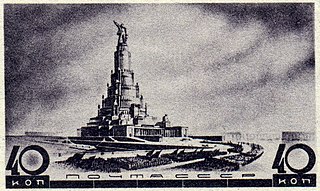
The Palace of the Soviets was a project to construct a political convention center in Moscow on the site of the demolished Cathedral of Christ the Saviour. The main function of the palace was to house sessions of the Supreme Soviet in its 130-metre (430 ft) wide and 100-metre (330 ft) tall grand hall seating over 20,000 people. If built, the 416-metre (1,365 ft) tall palace would have become the world's tallest structure, with an internal volume surpassing the combined volumes of the six tallest American skyscrapers. This was especially important to the Soviet state for propaganda purposes.

Stalinist architecture, mostly known in the former Eastern Bloc as Stalinist style or Socialist Classicism, is the architecture of the Soviet Union under the leadership of Joseph Stalin, between 1933 and 1955. Stalinist architecture is associated with the Socialist realism school of art and architecture.
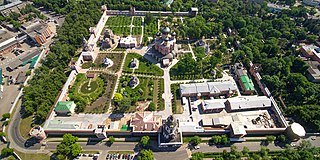
Donskoy Monastery is a major monastery in Moscow, founded in 1591 in commemoration of Moscow's deliverance from the threat of an invasion by the Crimean Khan Kazy-Girey. Commanding a highway to the Crimea, the monastery was intended to defend southern approaches to the Moscow Kremlin.
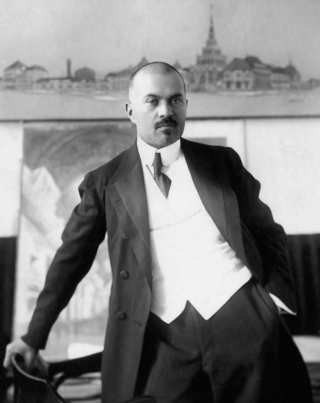
Alexey Victorovich Shchusev was a Russian and Soviet architect who was successful during three consecutive epochs of Russian architecture – Art Nouveau, Constructivism, and Stalinist architecture, being one of the few Russian architects to be celebrated under both the Romanovs and the communists, becoming the most decorated architect in terms of Stalin prizes awarded.
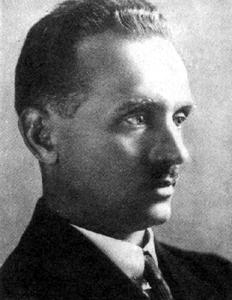
Konstantin Stepanovich Melnikov was a Russian architect and painter. His architectural work, compressed into a single decade (1923–33), placed Melnikov on the front end of 1920s avant-garde architecture. Although associated with the Constructivists, Melnikov was an independent artist, not bound by the rules of a particular style or artistic group. In 1930s, Melnikov refused to conform with the rising Stalinist architecture, withdrew from practice and worked as a portraitist and teacher until the end of his life.

Pavel Dmitriyevich Korin was a Russian painter and art restorer. He is famous for his preparational work for the unimplemented painting Farewell to Rus.

Pyotr Dmitrievich Baranovsky was a Russian architect, preservationist and restorator who reconstructed many ancient buildings in the Soviet Union. He is credited with saving Saint Basil's Cathedral from destruction in the early 1930s, founding and managing the Kolomenskoye and Andrei Rublev museums, and developing modern restoration technologies.
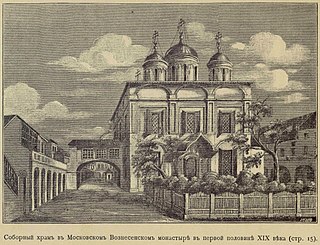
Ascension Convent, known as the Starodevichy Convent or Old Maidens' Convent until 1817, was an Orthodox nunnery in the Moscow Kremlin which contained the burials of grand princesses, tsarinas, and other noble ladies from the Muscovite royal court. It was destroyed in 1929 on Joseph Stalin's orders.

The former Moscow City Hall is an ornate red-brick edifice situated immediately to the east of the State Historical Museum and notable in the history of architecture as a unique hybrid of the Russian Revival and Neo-Renaissance styles. During Soviet times it served as the Lenin Museum in Moscow.

Vozdvizhenka Street,, is a radial street connecting Manege Square and Arbat Square in central Arbat District of Moscow, Russia. The street's name refers to a monastery that existed here since 1450 and perished in the Fire of Moscow (1812). In 1934–1946, it was known as Comintern Street, in 1946-1991 as Kalinin Street Kalinin Prospect.

Panteleimon Alexandrovich Golosov was a Constructivist architect from the Soviet Union and brother of Ilya Golosov.

Ivan Vladislavovich Zholtovsky was a Soviet and Russian architect and educator. He worked primarily in Moscow from 1898 until his death. An accomplished master of Renaissance Revival architecture before the Russian Revolution, he later became a key figure of Stalinist architecture.
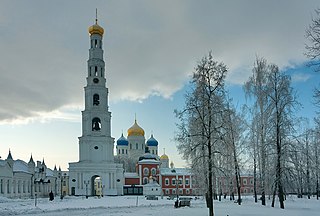
Nikolo-Ugreshsky Monastery is a walled stauropegic Russian Orthodox monastery of St. Nicholas the Miracle-Worker located in a suburb of Moscow, Dzerzhinsky. It is the town's main landmark and is featured on the city emblem.

The Federal Military Memorial Cemetery is a national cemetery of Russia, located in Mytishchinsky District, Moscow Oblast, on the north-eastern outskirts of Moscow.
People's Commissariat for Agriculture was set up in Petrograd in October 1917. Vladimir Milyutin was appointed the first People's Commissar of Agriculture. He was a member of the Council of People's Commissars (Sovnarkom).

An architecture museum is a museum dedicated to educating visitors about architecture in general or with a focus on a specific architectural style. Architecture museums may also educate visitors on the traditional history of architecture or art, which can provide useful context for many architecture exhibits. They are often chartered with the principle of advancing public education on how design can positively impact the human environment. Some architecture museums, such as the Chicago Athenaeum also educate visitors in a variety of other related fields, such as urban design, landscape design, interior design, and historic preservation.
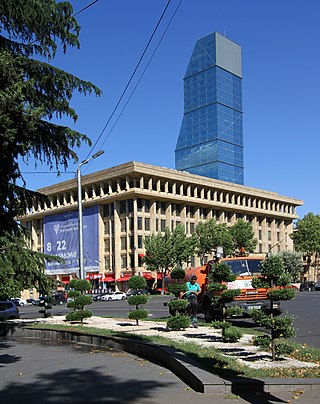
TheBiltmore Hotel Tbilisi is a luxury hotel in Tbilisi, the capital of Georgia, operated by the Millennium & Copthorne Hotels. The Biltmore Hotel Tbilisi is the first Biltmore outside of the United States and first hotel in the newly presented upscale luxury Biltmore Collection of the Millennium & Copthorne Hotels. The Grand Opening ceremony took place on July 31, 2016. Located on Rustaveli Avenue, the city's main thoroughfare, the hotel occupies the historical Soviet-era building IMELI, constructed in the 1930s, and a 32-floor skyscraper, built in the 2010s. Remaking of the old building as well as erection of the new one was heavily criticized by preservationists.

The Volkonsky House located at 9 Vozdvizhenka Street in central Moscow, Russia is considered the prototype of the house of old Prince Bolkonsky in Leo Tolstoy's 1869 novel War and Peace. The building was constructed in the 18th and 19th centuries, but was completely rebuilt in 2013, raising its height from two stories to four.





















